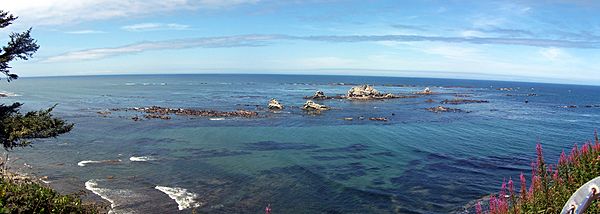List of shoals of Oregon facts for kids
A shoal is a natural pile of sand, gravel, or other loose material that forms an underwater or exposed area in a river or ocean. You might also hear them called bars, sandbars, spits, or reefs. The United States Geological Survey (USGS) keeps track of these natural formations.
Oregon has many of these interesting landforms. As of December 12, 2008, there were 156 known bars listed in the state!
Contents
What are Shoals, Bars, and Spits?
These terms describe similar landforms, but they have slight differences:
- A bar is a long, narrow ridge of sand or gravel that forms in a river or ocean. It can be completely underwater or stick out of the water.
- A sandbar is a type of bar made mostly of sand. They often shift and change shape with currents and tides.
- A spit is a narrow piece of land that sticks out into a body of water from the coastline. It's formed by currents carrying sand and depositing it.
- A shoal is a general term for a shallow area in a body of water, often caused by a bar or reef. It can be dangerous for boats because the water is not deep enough.
How Do They Form?
These landforms are created by the movement of water, like rivers and ocean currents. Water carries tiny bits of rock, sand, and other materials. When the water slows down, it drops these materials, and they start to pile up. Over time, these piles can grow into bars, spits, or shoals. Strong winds, waves, and tides also play a big role in shaping them.
The Famous Columbia Bar
One of the most well-known and important bars in Oregon is the Columbia Bar. This is where the mighty Columbia River meets the Pacific Ocean. It's a very busy shipping route, but also known for being quite dangerous due to strong currents and shifting sands.
The Columbia Bar system includes several smaller bars and spits:
- Peacock Spit and Clatsop Spit are located outside the main river mouth.
- Inside the Columbia River, near its mouth, you'll find places like Jetty Sands, Desdemona Sands, Baker Sands, Chinook Sands, Youngs River Sands, and Tongue Point Bar.
These sand formations are constantly changing, making navigation a challenge for ships entering and leaving the river.
Why Are They Important?
Shoals, bars, and spits are important for several reasons:
- Navigation: They can be tricky for boats, as they create shallow areas. Knowing where they are helps ships avoid getting stuck.
- Wildlife: Many of these areas are important habitats for birds, fish, and other marine life. For example, Simpson Reef is home to many seals and sea lions.
- Coastal Protection: Spits and bars can help protect coastlines from erosion by absorbing the energy of waves.
- Recreation: Some sandbars are popular spots for fishing, sunbathing, or just enjoying nature.
Oregon's shoals and bars are a natural part of its beautiful and ever-changing landscape, shaped by the powerful forces of water.

See also
- Lists of Oregon-related topics

